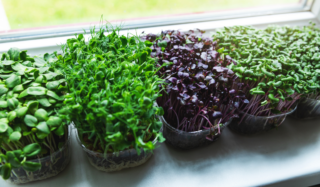Is the shortage of salad greens at the local supermarket getting you down? While they may seem simple, these greens boost flavour and nutritional value in any meal. So why not grow them at home? You don’t need much space, time or even a large budget to produce a couple of bags of organic salad mix a week.

Location, Location, Location
Find a spot in your house or yard that isn’t subjected to extreme heat, wind or other adverse conditions but receives enough sunlight to support fast, healthy growth.
Most houses and apartments have at least a windowsill with good morning light. Kitchen windowsills are often well-lit, incredibly convenient, and can look super cool! Or perhaps the best spot is a corner of your balcony or patio. If you don’t have any well-lit areas, you can produce greens directly in your pantry or a spare room with some small grow lights.
Container Time
Once you have your spot, you’ll need some containers to hold the soil. These containers should be big enough to give the plant’s roots plenty of room to spread out. However, the pots don’t have to be huge. Most salad greens are reasonably shallow-rooted. You can even grow plants in tiny containers as microgreens and harvest them as seedlings!

Long rectangular containers are preferred for many windowsill gardens. Aim for something at least 20cm deep by at least that wide for growing plants beyond the microgreen stage. You may be limited in what you can fit on your windowsill, but in the case of balcony gardens, 25 to 50-litre pots work great, and you can often grow various plants in the same pot.
Selecting Soil
Fill your chosen containers with the best soil you can afford; it should be fortified with good-quality organic ingredients and drain freely. These plants have simple requirements and mostly crave nitrogen. Nitrogen-rich organic fertilisers, like blood meal, feather meal, or fish amino acids and hydrolysate, can be applied when watering to supplement the plants and boost the growth rate.
Growing The Goods
The best part is deciding what you want to grow! Choose greens you like, but don’t be afraid to have some fun and grow weird and wonderful varieties that aren’t available at the local grocery store. Invite some friends to grow alongside you; everyone selects different plant varieties. There is something special about sharing surplus seedlings and products with others. The more people who grow, the more sustainable we will be!